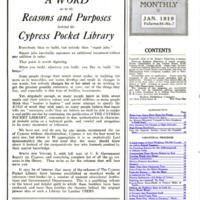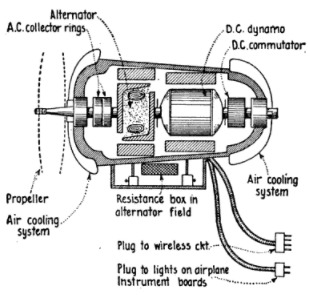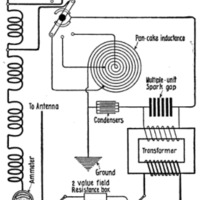Apparatus for sending wireless messages from airplanes
Item
-
Title (Dublin Core)
-
Apparatus for sending wireless messages from airplanes
-
Article Title and/or Image Caption (Dublin Core)
-
Apparatus for Sending Wireless Messages from Airplanes
-
extracted text (Extract Text)
-
PICTURE yourself speeding aloft
in a wireless-equipped airplane
with two officers of the Signal
Corps to obtain information that will
silence an enemy battery. The day is
clear, but it is difficult to locate the
guns because of the camouflage. Sud-
denly a bomb exposes a suspicious bit
of landscape.
“There they are!” cries the observer.
The others look in the direction in
which he points. Far below they see
what he has discovered—the well
masked muzzles of the guns that have
caused so much destruction. Even the
soldiers manning them are momentari-
ly in sight.
The observer quickly turns to his
wireless set and signals headquarters,
telling just in what direction he has
calculated the gunners’ fire should be
directed. Almost within the instant
the hand of the operator leaves the
transmitting key a veritable hail of
shells begins to fall about the battery.
They just fail to reach their mark,
however, so the observer sends another
message to headquarters—new direc-
tions for aiming. Then the fire is
swung slightly to the left and directed
squarely on the objective. The wire-
less has accomplished its mission, and
the airplane descends to the earth.
An inspection of the radio apparatus
in the airplane shows that it is some-
what light. Mounted on the forward
part of the flying machine is a tapering
metal case, hardly eleven inches long
and about six inches in diameter, yet
this contains an alternating-current
generator of two-thirds horsepower
and a direct-current dynamo to excite
the alternator. When the airplane
is in operation the propeller is driven
around 4,600 times a minute. The
dynamos on the same shalt whirl
around with it, and are thus made to
50 around ten times un fast na tho
Wheels of an automobile traveling at
forty miles an hour.
The alternator does away with un
interrupter on a spark coll. The
rapidly roveniag current s led directly
into the transformer primary. The
current emerging from the secondary |
winding, now stepped up to u very |
high voltage, finds itself first charging
the plates of the spark gap and then
overwhelming the air resistance and |
breaking through in the form of an
cletric spark. The condenser in the
circuit. shunting tho gap has in the
meantime rocoivod a chargo alo, and
the upark has helped to close the cir-
cuit containing the pancake induc-
tance, the gap and the condenser.
Following the rest of the cireui, it is
observed that the pancake is tapped
directly onto the antenna and ground.
The antenna consists of a reel of wire
buck of the observer's seat. This is
unwound as the airplane takes the
air and the antenna is lowered about
135 feat. A metal bobbin on the end
of it keeps this wire from fluttering
as it is swept almost horizontally in a
long graceful curve by the wind. The
“ground,” on the other hand, is merely
the wire stays between the planes
and inside of the canvas covering of
the wings.
The controls by which the operator
tunes hia set are on top of the instru
ment caso mounted at the front of his
compartment. With the first control
ho is able to change the power from
the alternator from low to high us he
gots farther and farther away from
his lines. When the switch is thrown
to high, the sparkegap length is in-
creased automatically, so tht he may
be sure that the spark will work as
efficiently as before. Throwing the
next control simply adds or subtracts
some of the pancake’s inductance so
that any of the three wavelengths of
150, 200 or 250 meters may be quickly
obtained. By this means, should the
airman wish to report a maneuver he
has discovered to a station, other than
his own, he changes to the different
wavelengths of that station, Every
time he does this he varies the induc-
tance in the antenna circuit slightly
until the ammeter in the same circuit
shows that the greatest amount of
power is being radiated.
‘This, then, is what you would have
to be familiar with if you were an
officer of the Signal Corps detailed to
airplane observation work. But then,
you may say, you have not been told
how the receiving is accomplished.
The answer to this is that it is not the
usual practice. It can be done, but
the added incumbrance to the aviator
and the necessity for increasing the
‘complexity of the system to overcome
the noise from the engine and the
rush of the air are advanced as argu-
ments against it. The observer is
given bh orders before ascending.
These he must fulfill to the letter;
furthermore, he is expected to use
initiative in the “tight places"—
when, for instance, he is menaced by
anti-aircraft guns or enemy wireless
men “Jam his messages.
-
Contributor (Dublin Core)
-
Lloyd Kuh (Article writer)
-
Language (Dublin Core)
-
eng
-
Date Issued (Dublin Core)
-
1919-01
-
pages (Bibliographic Ontology)
-
96
-
Rights (Dublin Core)
-
Public domain (Google digitized)
-
Archived by (Dublin Core)
-
Davide Donà
-
Marco Bortolami (editor)
 Popular Science Monthly, v. 94, n. 1, 1919
Popular Science Monthly, v. 94, n. 1, 1919




